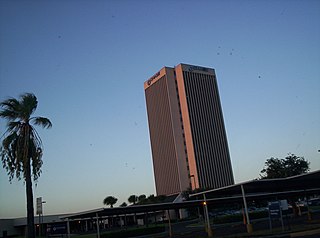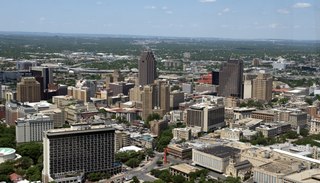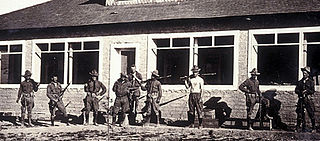
The Texas Ranger Division, commonly called the Texas Rangers and also known as Los Diablos Tejanos, is an investigative law enforcement agency with statewide jurisdiction in the U.S. state of Texas. It is based in the capital city of Austin. In the time since its creation, the Texas Rangers have investigated crimes ranging from murder to political corruption, acted in riot control and as detectives, protected the governor of Texas, tracked down fugitives, served as a security force at important state locations, including the Alamo, and functioned as a paramilitary force at the service of both the Republic (1836–1846) and the State of Texas.

The Lower Rio Grande Valley, commonly known as the Rio Grande Valley or locally as the Valley or RGV, is a region spanning the border of Texas and Mexico located in a floodplain of the Rio Grande near its mouth. The region includes the southernmost tip of South Texas and a portion of northern Tamaulipas, Mexico. It consists of the Brownsville, Harlingen, Weslaco, Pharr, McAllen, Edinburg, Mission, San Juan, and Rio Grande City metropolitan areas in the United States and the Matamoros, Río Bravo, and Reynosa metropolitan areas in Mexico. The area is generally bilingual in English and Spanish, with a fair amount of Spanglish due to the region's diverse history and transborder agglomerations It is home to some of the poorest cities in the nation, as well as many unincorporated, persistent poverty communities called colonias. A large seasonal influx occurs of "winter Texans" — people who come down from the north for the winter and then return north before summer arrives.

South Texas is a region of the U.S. state of Texas that lies roughly south of—and includes—San Antonio. The southern and western boundary is the Rio Grande, and to the east it is the Gulf of Mexico. The population of this region is about 4.96 million according to the 2017 census estimates. The southern portion of this region is often referred to as the Rio Grande Valley. The eastern portion along the Gulf of Mexico is also referred to as the Coastal Bend.

Juan Nepomuceno Cortina Goseacochea, also known by his nicknames Cheno Cortina, the Red Robber of the Rio Grande and the Rio Grande Robin Hood, was a Mexican rancher, politician, military leader, outlaw and folk hero. He was an important caudillo, military general and regional leader, who effectively controlled the Mexican state of Tamaulipas as governor. In borderlands history he is known for leading a paramilitary mounted Mexican Militia in the failed Cortina Wars. The "Wars" were raids targeting Anglo-American civilians whose settlement Cortina opposed near the several leagues of land granted to his wealthy family on both sides of the Rio Grande. Anglo families began immigrating to the Lower Rio Grande Valley after the Mexican Army was defeated by the Anglo-Mexican rebels of the Mexican State of Tejas, in the Texas Revolution.

The Cortina Troubles is the generic name for the First Cortina War, from 1859 to 1860, and the Second Cortina War, in 1861, in which paramilitary forces led by the Mexican rancher and local leader Juan Cortina, confronted elements of the United States Army, the Confederate States Army, the Texas Rangers, and the local militias of Brownsville, Texas, and Matamoros, Tamaulipas.

John Salmon Ford, better known as "Rip" Ford, was a member of the Republic of Texas Congress and later the Texas Senate, and mayor of Brownsville, Texas. He was also a Texas Ranger, a Confederate colonel, a doctor, a lawyer, and a journalist and newspaper owner. Ford commanded men during the Antelope Hills expedition, and he later commanded the Confederate forces in what was arguably the last engagement of the American Civil War, the Battle of Palmito Ranch on May 12–13, 1865. It was a Confederate victory, but as it occurred more than a month after Robert E. Lee's surrender, it did not affect the war's outcome.

Leander Harvey McNelly was a Confederate officer and Texas Ranger captain. McNelly is best remembered for leading the "Special Force", a quasi-military branch of the Texas Rangers that operated in south Texas in 1875–76.
The origins of today's Texas Ranger Division trace back to the first days of Anglo-American settlement of what is today the State of Texas, when it was part of the Province of Coahuila y Tejas belonging to the newly independent country of Mexico. The unique characteristics that the Rangers adopted during the force's formative years and that give the division its heritage today—characteristics for which the Texas Rangers would become world-renowned—have been accounted for by the nature of the Rangers' duties, which was to protect a thinly populated frontier against protracted hostilities, first with Plains Indian tribes, and after the Texas Revolution, hostilities with Mexico.

The Mexican Border War, or the Border Campaign, refers to the military engagements which took place in the Mexican–American border region of North America during the Mexican Revolution. The period of the war encompassed World War I, and the German Empire attempted to have Mexico attack the United States, as well as engaging in hostilities against American forces there itself.

The Plan of San Diego was drafted in San Diego, Texas, in 1915 by a group of unidentified Mexican and Tejano rebels who hoped to seize Arizona, New Mexico, California, and Texas from the United States. "It is called for a general uprising, scheduled for February 20, 1915, and the assassination of every non Latin male over 16 years of age-the strike are to include all of South Texas. Germans were excluded from the killings, and shortly thereafter the infamous Zimmermann Note disclosed German efforts to involve Mexico and American in war, thereby diverting American aid to the allies. The San Diego Plan was part of the plot, which collapsed immediately on discovery"..
The Ojo de Agua Raid was the last important military engagement between Mexican Seditionistas and the United States Army. It took place at Ojo de Agua, Texas. As part of the Plan of San Diego, the rebels launched a raid across the Rio Grande into Texas on October 21, 1915 aimed at harassing the American outposts along the Mexican border and disrupting the local economy. After moving across the border, the Seditionistas began an assault against the United States Army Signal Corps station at Ojo de Agua. The small group of American defenders was cornered into a single building and suffered heavy casualties before reinforcements arrived driving the Seditionist force back into Mexico. The raid proved to be the tipping point in the American conflict with the Seditionistas, as its severity convinced American officials to send large numbers of American troops to the area in order to deter any further serious border raids by the Mexican force.
The Raid onNorias Ranch was an incident in August 1915 in which a large band of Mexican Seditionistas attacked an American ranch in southern Texas. It became one of the many small battles fought on American soil during the Mexican Revolution and resulted in an increased effort by the United States Army to defend the international border. At least seven people were killed in the raid and several more from among those wounded by gunfire may have died immediately afterwards.

The raid on Glenn Springs occurred on the night of May 5–6, 1916, when Mexican Villistas and Carrancistas attacked the towns of Boquillas and Glenn Springs, Texas. In Glenn Springs, the raiders burned several buildings and fought a three-hour battle with a small force of American soldiers who were stationed there. At the same time, a second party of rebels robbed a general store and a silver mine in Boquillas. Four Americans were killed and the rebels took two hostages to Coahuila. In response to the attack, the United States Army launched a short punitive expedition into Mexico, fought with the rebels, and rescued the captives.

The Brite Ranch raid was an incident that occurred on Christmas Day 1917, in which Mexican raiders crossed the Rio Grande River border and attacked a ranch in Presidio County, Texas. At the time the raiders were thought to be Villistas, as they had been responsible for several other previous incursions into American territory, though other accounts say that some Carrancistas were involved as well. During the raid the Mexicans murdered three people, robbed a general store and rode back to Chihuahua under pursuit by a motorized posse and troops of the United States Army 8th Cavalry. The Americans fought a running battle with the Mexicans on December 26 that resulted in the deaths of several raiders and the recovery of some stolen property. Soon after, an expedition to find more of the raiders led to another more violent episode when, on January 27, 1918, a force of Texas Rangers accompanied by US Cavalry, executed 15 Mexican men in what became known as the Porvenir Massacre.

The Nevill Ranch raid occurred on the night of March 25, 1918, and was the last serious attack on a Texas ranch by Mexican rebels during the Bandit War. It is not certain, but there was reason to believe that Villistas were responsible for the raid in which two people were murdered. Afterwards, the rebels withdrew to the village of Pilares, Chihuahua, in Mexican territory, under pursuit by a group of United States cavalry. A small battle was fought at Pilares on the following day, several more people were killed, and the Americans burned the village before they returned to Texas.
The Raid onSan Ygnacio refers to a battle fought on June 15, 1916 between the United States Army and Mexican raiders near the border town of San Ygnacio, Texas. Three different Mexican factions were known to have launched raids into Texas at the time but most of the evidence suggests that either Seditionists or Carrancistas were responsible for the incursion. Four American soldiers were killed during the battle, along with at least six of the raiders, and the resulting American punitive expedition further strained the already hostile relationship between the Mexican and United States governments.

The Battle of La Ebonal was fought in December 1859 near Brownsville, Texas during the First Cortina War. Following the Brownsville Raid, on September 28, and a few skirmishes with the Texas Rangers, rebel leader Juan Cortina led his small army into the hills outside of town and dug in near a series of cattle ranches. The United States Army responded by sending an expedition into the area, under the command of Major Samuel P. Heintzelman, with orders to pacify all resistance. A minor battle began on December 13, at a ranch called La Ebonal, and continued for a few hours as the Americans routed and then pursued the retreating Cortinistas.

The Porvenir massacre was an incident on January 28, 1918 outside the village of Porvenir, in Presidio County, Texas, in which Texas Rangers and local ranchers, with the support of U.S. Cavalry, killed 15 unarmed Mexican American boys and men. The Texas Rangers Company B had been sent to the area to stop banditry after the Brite Ranch raid. Despite having no evidence that the Porvenir villagers had been involved in recent thefts or the killings of ranchers, the Rangers separated 15 men and boys from the rest of the village and shot them on a nearby hill.
José Tomás Canales was an American businessman, lawyer, and politician based in Texas. He served five terms in the State House, where he was the only Mexican-American representative at the time. He is best known for his work on behalf of Mexican-Americans and Tejanos in Texas, defending civil rights of Latin Americans and other minorities.
La Matanza and the Hora de Sangre was a period of anti-Mexican violence in Texas, including lynchings and massacres, between 1910 and 1920 in the midst of tensions between the United States and Mexico during the Mexican Revolution. This violence was committed by Anglo-Texan vigilantes, and law enforcement, such as the Texas Rangers, during operations against bandit raids known as the Bandit Wars. The violence and denial of civil liberties during this period was justified by racism. Ranger violence reached its peak from 1915 to 1919, in response to increasing conflict, initially because of the Plan de San Diego, by Mexican and Tejano insurgents to take Texas. This period was referred to as the Hora de Sangre by Mexicans in South Texas, many of whom fled to Mexico to escape the violence. At least 300 Mexican Americans were killed in Texas during the 1910s, with total estimates of ranging from hundreds to thousands killed. At least 100 Mexican Americans were lynched in the 1910s, many in Texas. Many murders were concealed and went unreported, with some in South Texas, suspected by Rangers of supporting rebels, being placed on blacklists and often "disappearing".












